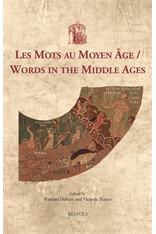Les Mots au Moyen Âge – Words in the Middle Ages, ed. Victoria Turner and Vincent Debiais (Turnhout, 2020: USML 46), ISBN 978-2-503-58795-0.
This collection of essays is a return to words of the Middle Ages in and of themselves, uniting philologists, historians, epigraphers, palaeographers, and art historians. It probes the intellectual, technical, and aesthetic principles that underpin their use and social function in medieval graphical practices, from epigraphy and inscriptions, to poetics, ‘mots’, and ‘paroles’. By analysing the material and symbolic properties of a particular medium, the conditions in which texts become signs, and scribal expertise, the contributors address questions that initially seem simple yet which define the very foundations of medieval written culture. What is a word? What are its components? How does it appear in a given medium? What is the relationship between word and text, word and letter, word and medium, word and reader? In a Middle Ages forever torn between economic and extravagant language, this volume traces the status of the medieval word from ontology to usage, encompassing its visual, acoustic, linguistic, and extralinguistic forms.
Contents:
Victoria Turner et Vincent Debiais, “Introduction”
Adrian Papahagi, “Words with Masks: A Note on the Nomenclature of Some Late Medieval Initials”
Dominique Stutzmann, “Words as Graphic and Linguistic Structures: Word Spacing in Psalm 101 Domine exaudi orationem meam (Eleventh-Fifteenth Centuries)”
Anne Rauner, “Managing a Living Book: The Planning and the Use of Page Surface in Parish Obituaries in the Late Medieval Diocese of Strasbourg”
Arthur Westwell, “Correction of Liturgical Words, and Words of Liturgical Correctio in the Ordines Romani of Saint Amand”
Jennifer M. Feltmann, “Aligning Word and Deed: The Emergence of Confessor as a Priest Who Hears Confession”
Lucas Wood, “The Origin of the Text and the Authority of the Word in Robert de Boron’s Joseph d’Arimathie”
Morgan Boharski, “Kisses on Stitches: Words of Active Fetishisation of Cloth Bodies in Old French Romance”
Liam Lewis, “Quacktrap: Glosses and Multilingual Animal Contact in the Tretiz of Walter of Bibbesworth”
Morgane Uberti, “Un règne sans roi: Le non-dit du temps dans quelques inscriptions de la Gaule du haut Moyen Âge”
Estelle Ingrand-Varenne, “Nommer, couper, incorporer: Quand le nom rencontre le corps de l’image”
Katja Airaksinen-Monier, “Mirror Writing in Devotional Texts and Images”
Caroline Schärli, “Encircling Inscriptions in Early Byzantine and Carolingian Sacral Buildings”
Francisco de Asís García García, “Épigraphie et création artistique à l’époque romane: Le paysage monumental du Haut-Aragon autour de 1100”
Jörg Widmaier, “Between Written and Spoken Words: The Use and Function of Inscriptions on Medieval Baptismal Fonts”


